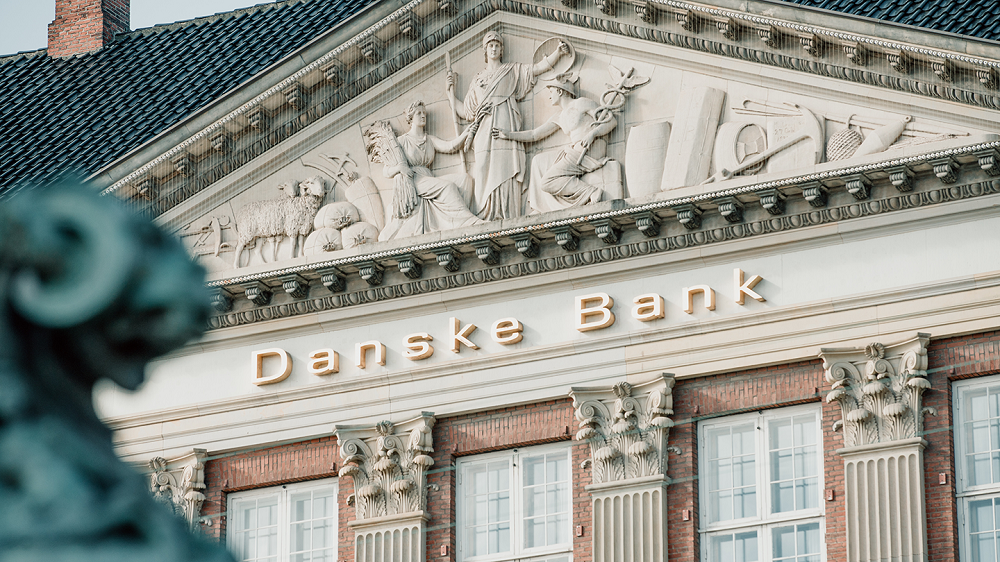
Region:Europe
Industry:Banking and Financial Services
Client:Danske Bank
Danske Bank expands citizen developer program and intelligent automation

250
automation solutions
50
citizen developers
300
FTE saved
1.3%
of all work is automated (with a vision of 4%)
Client Overview
Danske Bank has a history stretching back over 150 years. In that time, it’s grown to serve 3.3 million customers, employing 21,500 people. Providing financial services for corporates and consumers alike, they’re served from locations as diverse as Denmark, Finland, India, Lithuania, Norway and Sweden.
Danske Bank’s roots go back to 1871, with the formation of Landmandsbank. Since then, it’s grown and merged to become the largest bank in Denmark, operating extensively across the Nordic countries and beyond.
In doing so, one thing has remained constant: innovation. The company pioneered overdrafts in the 1800s, ground-breaking electronic data processing in the 1960s, and more recently, mobile payments and banking. Following this trend, it began exploring robotic process automation (RPA) in 2015.

Gyte Gedvilaite-Hansen is Danske Bank’s Head of NewTech, Standards, and Infrastructure in the Intelligent automation Center of Excellence (CoE), a role she’s held for the last two years. “Our automation journey started as a local initiative to optimize a single process. Very quickly, the business realized it needed to embrace the technology and manage it efficiently,” she says.
This led to the creation of the first CoE, which controlled standards, supplied infrastructure and monitored using RPA. “It was a distributed model where local business analysts and developers worked throughout the company,” Gedvilaite-Hansen adds.
Reinventing the CoE
Then, two years ago, Sarune Galdikaite, Danske Bank’s Head of Intelligent Automation reinvented the CoE. As part of a bigger transformation happening in the bank, the Automation teams were centralized to become more strategic.
“The biggest difference between the old CoE and new is our ability to serve the whole business, automating end-to-end processes,” Galdikaite explains. This saw RPA move from the back office, where most work had been automated, to the front.
Our first big project was creating a robot to prepare customer service agents for client meetings. Prior to each session, employees needed to manually collate information from a range of systems. It used to take 20-30 minutes each time. With the robot, staff just sent an email outlining their requirement and within five minutes received everything, allowing the advisors to focus on higher value work.

It was a huge success. Nor did it save precious time, but it also opened the eyes of customer-facing staff to the power of automation. “The journey from there has been great. We’ve tripled the number of processes in the front office,” Galdikaite smiles.
There are 250 automation solutions across the bank doing work equivalent to 300 FTE, with 65 people in the CoE to facilitate it. Local automation ambassadors work with staff to find processes ripe for automation. But doing so requires sensitivity.
A careful approach
“We need to approach automation carefully, speaking to employees at the right time; when they’re not too busy,” Galdikaite cautions. She and Gedvilaite-Hansen deliberately position RPA as a supporting technology. “We explain that the software’s here to help, to allow people to focus on complex work. Essentially, we want people to be using their brains, not their fingers.”

By this she means staff need to be freed from time-consuming and repetitive tasks such as data entry so they can tackle work that’s uniquely suited to human ingenuity and problem solving. To put it another way, “A person can’t be automated, but a process can,” Galdikaite chips in.
With so many robots working for Danske Bank, the CoE’s keen to ensure they’re constantly improved and managed effectively. Galdikaite has a novel approach to this. “We work closely with HR, giving each robot a staff ID, access rights and a line manager. They receive reviews just like other members of the team to ensure they’re working at peak performance.”
Impressive results
This approach is certainly working, with robots now undertaking the equivalent work of 300 full-time employees. That’s 1.3 percent of the entire workforce. “This year alone, we’ve created automations equating to 60 full-time members of staff,” Galdikaite notes with pride.
The team has an ambition to increase the proportion of work completed by robots to 4 percent in the future. “We’ve even dreamed of reaching 10 percent one day,” Galdikaite enthuses.
Looking ahead
There are three next steps on Danske Bank’s automation journey. Firstly, it expects using intelligent automation (IA) to grow. This is where RPA is combined with artificial intelligence (AI) and other complementary technologies to enhance its capabilities. “Inevitably, we will see more IA,” says Galdikaite. “The world is changing and one day we will fully embrace it.”

The second step is using attended robots—or robotic desktop automation (RDA) as Danske Bank calls it. “We’ve explored these in the past, but they’ve not been as efficient as we needed,” Galdikaite explains. RDA is software UiPath is uniquely positioned to deliver in comparison to other vendors. In fact, Danske Bank recently added UiPath to its technology portfolio with this in mind.
The third focus will be the continued roll out of citizen developers. Put simply, a citizen developer is a non-technical user that creates basic automations for themselves and their departments. This will be vital if the CoE is to reach its targets.
Citizen developers
When asked why citizen developers are so important, Gedvilaite-Hansen answers, “There are two reasons. Firstly, we find it hard to say ‘no’ to all the people who want automations. Yet we must because our role is to focus on the bigger, more important processes. We don’t want to be creating hundreds of robots that do small amounts of work. Secondly, if we do say ‘no’, we run the risk of people doing it themselves using shadow IT.”
The CoE therefore needs a way to offload small automations to citizen developers, but in a way that’s governed effectively. Again, well positioned to achieve this with its Studio X software. This easy-to-use, low-code tool allows users to quickly create their own automations.
There are now about 50 citizen developers in the business. They’re building robots to transfer data, add comments to customer records or verify information.

Not only does this support staff in their jobs, but it keeps them in the post, too. With renewed skills and training, they’re less likely to look for a new position, which helps to reduce employee churn.
The vision
Thinking further ahead, the CoE has boundless ambition. “Eventually, we want each team in the business to have at least one digital colleague,” Galdikaite confides. “We’re aiming high. We’ve not realised the full potential of RPA and have an opportunity to do so.”
“We’re also constantly striving to go back to basics. To understand processes, improve them and get the most out of each robot. It’s much better to have fewer better robots delivering high value rather than many robots that don’t work to their full capacity.”
When asked what advice they'd give to other automation teams in financial services, Gedvilaite-Hansen and Galdikaite are full of wisdom. “Don’t automate a bad process,” Galdikaite says without dropping a beat. “And don’t try to automate everything. Learn what’s best for a robot and focus on the important tasks. Also, continually talk about RPA to the business. Keep it on the agenda.”

Gedvilaite-Hansen is keen to advise, “Track the benefits and show value. Without numbers and facts, you can’t build a business case. I’m always shocked when I hear that teams in other businesses don’t do this.”
Prompted by this comment, Galdikaite suggests, “Track your progress. When we started the new CoE, we created monthly reports and newsletters. The result is that decision makers discuss robots in meetings where they’d never been heard of before.”
Both are also keen that automation teams should look for novel use cases, pointing to examples they’ve developed. These include robots to set up accounts for Ukrainian refugees quickly, and others that have helped the bank with sanction screening aimed at Russia.
A vendor to support every step
It’s clear that Gedvilaite-Hansen and Galdikaite have a passion for what they do. And that’s translating into fantastic results for Danske Bank. As the team continues its journey, UiPath is now at its side, offering the tools and technology to allow new heights of achievement. No other automation technology vendor is positioned quite as well to help the bank boost productivity, reduce costs, gain a competitive edge, engage staff and delight customers.

In 150 years, the bank will look back on CoE’s work as a turning point in its history, akin to the introduction of other revolutionary software that made the company what it's today.
Ready for your own case study?
Speak to our team of knowledgeable experts and learn how you can benefit from agentic automation.
